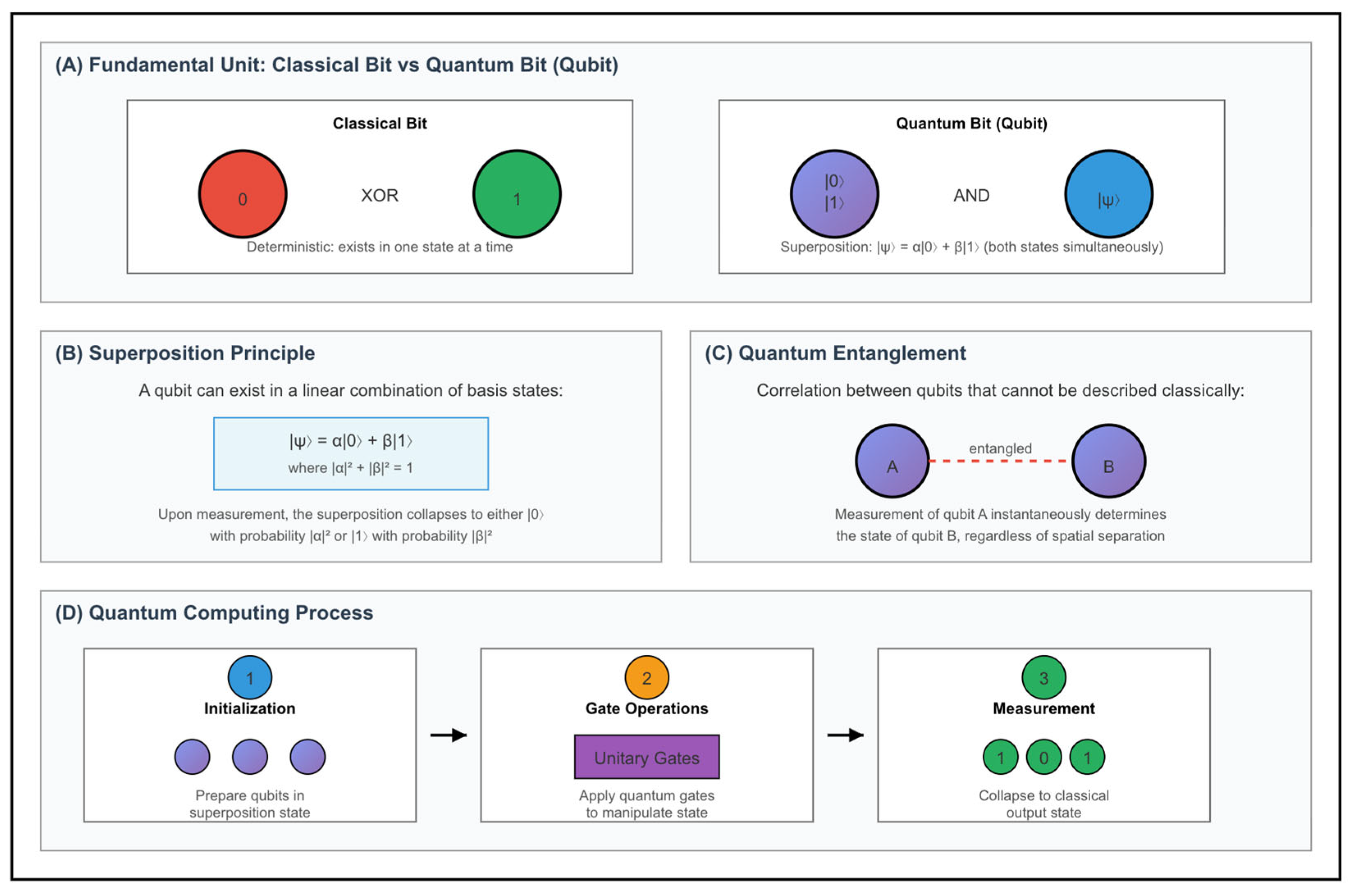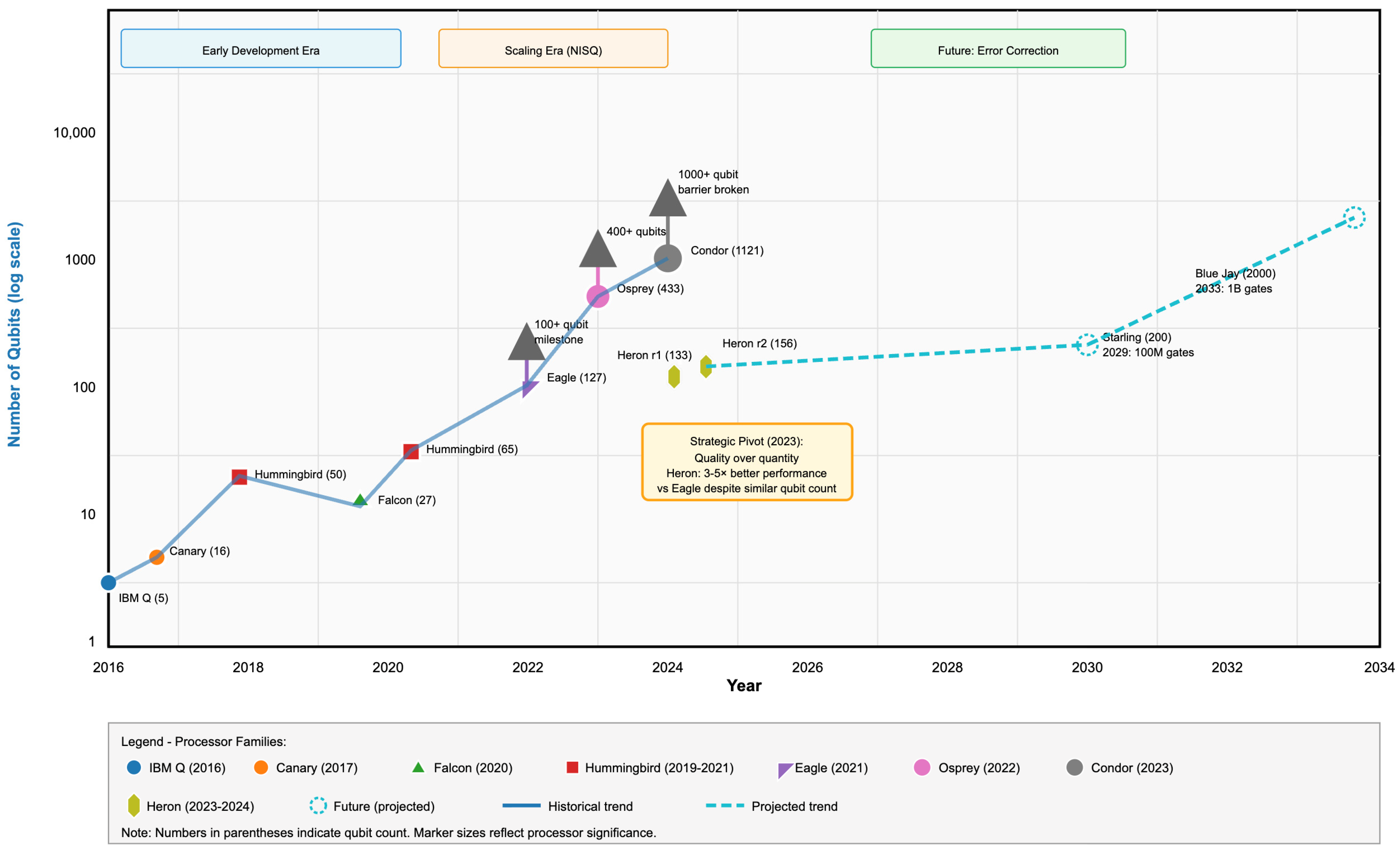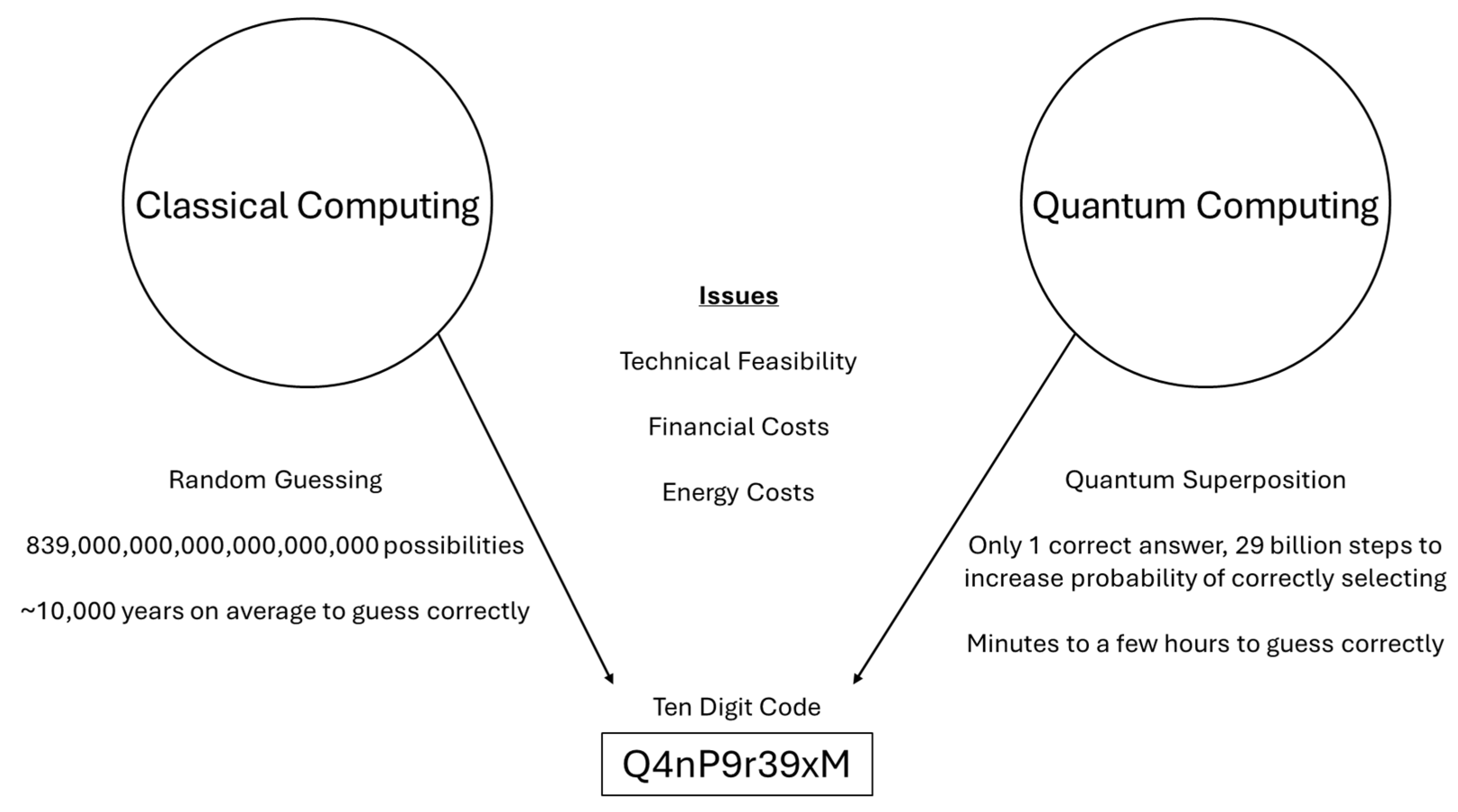Quantum Computing: A Concise Introduction
Definition
1. Introduction
2. Quantum Principles in Quantum Computing
2.1. Hardware for Quantum Computing
2.2. Quantum Algorithms
2.3. Computational Complexity and Quantum Advantage
- Class P (Polynomial Time) consists of problems that can be solved efficiently (i.e., in polynomial time) by a classical deterministic algorithm.
- Class NP (Nondeterministic Polynomial Time) includes problems for which proposed solutions can be verified efficiently, even if finding such solutions may not be feasible in polynomial time. One of the most prominent open questions in theoretical computer science is whether P = NP.
2.4. The Power of Quantum Computing
3. Areas of Quantum Computing’s Greatest Potential Impact
3.1. Cybersecurity and Post-Quantum Cryptography
3.2. Information Retrieval
3.3. Automation
4. The Post-Quantum Future
4.1. How Will Knowledge-Based Industries Evolve?
4.2. What Is the Future of Work?
4.3. What Becomes of the Human Mind?
4.4. Quantum Ethics and Policy
5. Conclusions
Funding
Institutional Review Board Statement
Informed Consent Statement
Data Availability Statement
Conflicts of Interest
References
- Barral, D.; Cardama, F.J.; Díaz-Camacho, G.; Faílde, D.; Llovo, I.F.; Mussa-Juane, M.; Vázquez-Pérez, J.; Villasuso, J.; Piñeiro, C.; Costas, N.; et al. Review of Distributed Quantum Computing: From single QPU to High Performance Quantum Computing. Comput. Sci. Rev. 2025, 57, 100747. [Google Scholar] [CrossRef]
- Steane, A.M. Efficient fault-tolerant quantum computing. Nature 1999, 399, 124–126. [Google Scholar] [CrossRef]
- Knill, E. Quantum computing. Nature 2010, 463, 441–443. [Google Scholar] [CrossRef] [PubMed]
- Lorenz, J.M.; Monz, T.; Eisert, J.; Reitzner, D.; Schopfer, F.; Barbaresco, F.; Kurowski, K.; van der Schoot, W.; Strohm, T.; Senellart, J.; et al. Systematic benchmarking of quantum computers: Status and recommendations. arXiv 2025, arXiv:2503.04905. [Google Scholar] [CrossRef]
- AbuGhanem, M. IBM quantum computers: Evolution, performance, and future directions. J. Supercomput. 2025, 81, 687. [Google Scholar] [CrossRef]
- Monroe, C.; Kim, J. Scaling the Ion Trap Quantum Processor. Science 2013, 339, 1164–1169. [Google Scholar] [CrossRef]
- Javadi-Abhari, A.; Treinish, M.; Krsulich, K.; Wood, C.J.; Lishman, J.; Gacon, J.; Martiel, S.; Nation, P.D.; Bishop, L.S.; Cross, A.W.; et al. Quantum computing with Qiskit. arXiv 2024, arXiv:2405.08810. [Google Scholar] [CrossRef]
- Cirq. Google Quantum AI. Available online: https://quantumai.google/cirq (accessed on 27 July 2025).
- Mykhailova, M. Teaching Quantum Computing Using Microsoft Quantum Development Kit and Azure Quantum. In Proceedings of the 2023 IEEE International Conference on Quantum Computing and Engineering (QCE), Bellevue, WA, USA, 17–22 September 2023; pp. 15–20. [Google Scholar] [CrossRef]
- Ruane, J.; Kiesow, E.; Galatsanos, J.; Dukatz, C.; Blomquist, E.; Shukla, P. Quantum Index Report 2025. arXiv 2025, arXiv:2506.04259. [Google Scholar] [CrossRef]
- Vankayalapati, R.K. Harnessing Quantum Cloud Computing: Impacts on Cryptography, AI, and Pharmaceutical Innovation. Soc. Sci. Res. Netw. 2022, 5065730. [Google Scholar] [CrossRef]
- Montanaro, A. Quantum algorithms: An overview. NPJ Quantum Inf. 2016, 2, 15023. [Google Scholar] [CrossRef]
- Shahriar, S.; Corradini, M.G.; Sharif, S.; Moussa, M.; Dara, R. The role of generative artificial intelligence in digital agri-food. J. Agric. Food Res. 2025, 20, 101787. [Google Scholar] [CrossRef]
- de Leon, N.P.; Itoh, K.M.; Kim, D.; Mehta, K.K.; Northup, T.E.; Paik, H.; Palmer, B.S.; Samarth, N.; Sangtawesin, S.; Steuerman, D.W. Materials challenges and opportunities for quantum computing hardware. Science 2021, 372, eabb2823. [Google Scholar] [CrossRef]
- Shannon, C.E. A mathematical theory of communication. Sigmobile Mob. Comput. Commun. Rev. 2001, 5, 3–55. [Google Scholar] [CrossRef]
- Deutsch, D.; Penrose, R. Quantum theory, the Church–Turing principle and the universal quantum computer. Proc. R. Soc. Lond. Math. Phys. Sci. 1997, 400, 97–117. [Google Scholar] [CrossRef]
- Sakurai, J.J.; Napolitano, J. Modern Quantum Mechanics, Higher Education from Cambridge University Press. Available online: https://www.cambridge.org/highereducation/books/modern-quantum-mechanics/DF43277E8AEDF83CC12EA62887C277DC (accessed on 27 July 2025).
- Haken, H.; Wolf, H.C. Molecular Physics and Elements of Quantum Chemistry: Introduction to Experiments and Theory; Springer Science & Business Media: Berlin/Heidelberg, Germany, 2013. [Google Scholar]
- Born, M. Quantenmechanik der Stoßvorgänge. Z. Für Physik. 1926, 38, 803–827. [Google Scholar] [CrossRef]
- Schrödinger’s Cat. Wikipedia. 8 July 2025. Available online: https://en.wikipedia.org/w/index.php?title=Schr%C3%B6dinger%27s_cat&oldid=1299475908 (accessed on 27 July 2025).
- Steane, A. Quantum Computing. Rep. Prog. Phys. 1998, 61, 117–173. [Google Scholar] [CrossRef]
- DiVincenzo, D.P. The Physical Implementation of Quantum Computation. Fortschritte Phys. 2000, 48, 771–783. [Google Scholar] [CrossRef]
- Kotochigova, S.; Gupta, S.; Blinov, B. Neutral Atoms in Optical Tweezers as Messenger Qubits for Scaling up a Trapped Ion Quantum Computer. arXiv 2025, arXiv:2501.04223. [Google Scholar] [CrossRef]
- Bruzewicz, C.D.; Chiaverini, J.; McConnell, R.; Sage, J.M. Trapped-ion quantum computing: Progress and challenges. Appl. Phys. Rev. 2019, 6, 021314. [Google Scholar] [CrossRef]
- Gyongyosi, L.; Imre, S. A Survey on quantum computing technology. Comput. Sci. Rev. 2019, 31, 51–71. [Google Scholar] [CrossRef]
- Saffman, M.; Walker, T.G.; Mølmer, K. Quantum information with Rydberg atoms. Rev. Mod. Phys. 2010, 82, 2313–2363. [Google Scholar] [CrossRef]
- O’Brien, J.L.; Furusawa, A.; Vučković, J. Photonic quantum technologies. Nat. Photonics 2009, 3, 687–695. [Google Scholar] [CrossRef]
- Pan, J.-W.; Chen, Z.-B.; Lu, C.-Y.; Weinfurter, H.; Zeilinger, A.; Żukowski, M. Multiphoton entanglement and interferometry. Rev. Mod. Phys. 2012, 84, 777–838. [Google Scholar] [CrossRef]
- Doherty, M.W.; Manson, N.B.; Delaney, P.; Jelezko, F.; Wrachtrup, J.; Hollenberg, L.C.L. The nitrogen-vacancy colour centre in diamond. Phys. Rep. 2013, 528, 1–45. [Google Scholar] [CrossRef]
- Childress, L.; Hanson, R. Diamond NV centers for quantum computing and quantum networks. MRS Bull. 2013, 38, 134–138. [Google Scholar] [CrossRef]
- Shor, P.W. Scheme for reducing decoherence in quantum computer memory. Phys. Rev. A 1995, 52, R2493–R2496. [Google Scholar] [CrossRef] [PubMed]
- Terhal, B.M. Quantum error correction for quantum memories. Rev. Mod. Phys. 2015, 87, 307–346. [Google Scholar] [CrossRef]
- Gottesman, D. Theory of fault-tolerant quantum computation. Phys. Rev. A 1998, 57, 127–137. [Google Scholar] [CrossRef]
- Girvin, S.M. Introduction to quantum error correction and fault tolerance. SciPost Phys. Lect. Notes 2023, 70. [Google Scholar] [CrossRef]
- Halevi, S.; Krawczyk, H. Public-key cryptography and password protocols. ACM Trans. Inf. Syst. Secur. 1999, 2, 230–268. [Google Scholar] [CrossRef]
- Grover, L.K. A fast quantum mechanical algorithm for database search. In Proceedings of the Twenty-Eighth Annual ACM Symposium on Theory of Computing, in STOC’96, Philadelphia, PA, USA, 22–24 May 1996; Association for Computing Machinery: New York, NY, USA, 1996; pp. 212–219. [Google Scholar] [CrossRef]
- Grover, L.K. Quantum Mechanics Helps in Searching for a Needle in a Haystack. Phys. Rev. Lett. 1997, 79, 325–328. [Google Scholar] [CrossRef]
- Shor, W. Algorithms for quantum computation: Discrete logarithms and factoring. In Proceedings of the 35th Annual Symposium on Foundations of Computer Science, Santa Fe, NM, USA, 20–22 November 1994; pp. 124–134. [Google Scholar] [CrossRef]
- Boneh, D. Twenty Years of Attacks on the RSA Cryptosystem. Not. AMS 1999, 46, 203–213. [Google Scholar]
- Monz, T.; Nigg, D.; Martinez, E.A.; Brandl, M.F.; Schindler, P.; Rines, R.; Wang, S.X.; Chuang, I.L.; Blatt, R. Realization of a scalable Shor algorithm. Science 2016, 351, 1068–1070. [Google Scholar] [CrossRef]
- Goldreich, O. P, NP, and NP—Completeness: The Basics of Computational Complexity; Cambridge University Press: Cambridge, UK, 2010. [Google Scholar]
- Arora, S.; Barak, B. Computational Complexity: A Modern Approach; Cambridge University Press: Cambridge, UK, 2009. [Google Scholar]
- Nielsen, M.A.; Chuang, I.L. Quantum Computation and Quantum Information: 10th Anniversary Edition; Cambridge University Press: Cambridge, UK, 2010. [Google Scholar]
- Aaronson, S. Quantum computing, postselection, and probabilistic polynomial-time. Proc. R. Soc. Math. Phys. Eng. Sci. 2005, 461, 3473–3482. [Google Scholar] [CrossRef]
- Shor, P.W. Polynomial-Time Algorithms for Prime Factorization and Discrete Logarithms on a Quantum Computer. SIAM Rev. 1999, 41, 303–332. [Google Scholar] [CrossRef]
- Tazawa, S. Integer factorization and Discrete Logarithm problem are neither in P nor NP-complete. arXiv 2012, arXiv:1207.2171. [Google Scholar] [CrossRef]
- Moret-Bonillo, V. Can artificial intelligence benefit from quantum computing? Prog. Artif. Intell. 2015, 3, 89–105. [Google Scholar] [CrossRef]
- Joseph, D.; Misoczki, R.; Manzano, M.; Tricot, J.; Pinuaga, F.D.; Lacombe, O.; Leichenauer, S.; Hidary, J.; Venables, P.; Hansen, R. Transitioning organizations to post-quantum cryptography. Nature 2022, 605, 237–243. [Google Scholar] [CrossRef] [PubMed]
- Bernstein, D.J.; Lange, T. Post-quantum cryptography. Nature 2017, 549, 188–194. [Google Scholar] [CrossRef]
- Preskill, J. Quantum Computing in the NISQ era and beyond. Quantum 2018, 2, 79. [Google Scholar] [CrossRef]
- Chakrabarty, I.; Khan, S.; Singh, V. Dynamic Grover search: Applications in recommendation systems and optimization problems. Quantum Inf. Process. 2017, 16, 153. [Google Scholar] [CrossRef]
- Carr, P.L. Reimagining the Library as a Technology: An Analysis of Ranganathan’s Five Laws of Library Science within the Social Construction of Technology Framework. Libr. Q. 2014, 84, 152–164. [Google Scholar] [CrossRef]
- Quetschlich, N.; Burgholzer, L.; Wille, R. MQT Bench: Benchmarking Software and Design Automation Tools for Quantum Computing. Quantum 2023, 7, 1062. [Google Scholar] [CrossRef]
- Floridi, L. The Fourth Revolution: How the Infosphere is Reshaping Human Reality, 1st ed.; Oxford University Press: New York, NY, USA, 2014. [Google Scholar]
- Dupouët, O.; Pitarch, Y.; Ferru, M.; Bernela, B. Community dynamics and knowledge production: Forty years of research in quantum computing. J. Knowl. Manag. 2023, 28, 651–672. [Google Scholar] [CrossRef]
- Quantum Technology and Application Consortium—QUTAC; Bayerstadler, A.; Becquin, G.; Binder, J.; Botter, T.; Ehm, H.; Ehmer, T.; Erdmann, M.; Gaus, N.; Harbach, P.; et al. Industry quantum computing applications. EPJ Quantum Technol. 2021, 8, 25. [Google Scholar] [CrossRef]
- Gill, S.S.; Buyya, R. Transforming research with quantum computing. J. Econ. Technol. 2024, 4, 1–8. [Google Scholar] [CrossRef]
- Ravi, G.S.; Smith, K.N.; Gokhale, P.; Chong, F.T. Quantum Computing in the Cloud: Analyzing job and machine characteristics. In Proceedings of the 2021 IEEE International Symposium on Workload Characterization (IISWC), Providence, RI, USA, 7–9 November 2021; pp. 39–50. [Google Scholar] [CrossRef]
- Gill, S.S.; Kumar, A.; Singh, H.; Singh, M.; Kaur, K.; Usman, M.; Buyya, R. Quantum computing: A taxonomy, systematic review and future directions. Softw. Pract. Exp. 2022, 52, 66–114. [Google Scholar] [CrossRef]
- Möller, M.; Vuik, C. On the impact of quantum computing technology on future developments in high-performance scientific computing. Ethics Inf. Technol. 2017, 19, 253–269. [Google Scholar] [CrossRef]
- Greinert, F.; Müller, R.; Bitzenbauer, P.; Ubben, M.S.; Weber, K.-A. Future quantum workforce: Competences, requirements, and forecasts. Phys. Rev. Phys. Educ. Res. 2023, 19, 010137. [Google Scholar] [CrossRef]
- Hughes, C.; Finke, D.; German, D.-A.; Merzbacher, C.; Vora, P.M.; Lewandowski, H.J. Assessing the Needs of the Quantum Industry. IEEE Trans. Educ. 2022, 65, 592–601. [Google Scholar] [CrossRef]
- Ashktorab, Z.; Weisz, J.D.; Ashoori, M. Thinking Too Classically: Research Topics in Human-Quantum Computer Interaction. In Proceedings of the 2019 CHI Conference on Human Factors in Computing Systems, in CHI’19, Glasgow, UK; Association for Computing Machinery: New York, NY, USA, 2019; pp. 1–12. [Google Scholar] [CrossRef]
- Perrier, E. Ethical Quantum Computing: A Roadmap. arXiv 2022, arXiv:2102.00759. [Google Scholar] [CrossRef]
- Lund, B.D.; Wang, T. Chatting about ChatGPT: How may AI and GPT impact academia and libraries? Libr. Hi Tech News 2023, 40, 26–29. [Google Scholar] [CrossRef]
- Minoli, D.; Occhiogrosso, B. Quantum Computers. In Quantum Communication and Quantum Internet Applications; Auerbach Publications: Boca Raton, FL, USA, 2025. [Google Scholar]



| Category | Platform | Type | Connectivity | Strengths | Limitations | Maturity |
|---|---|---|---|---|---|---|
| Hardware | Google Willow [4] | Superconducting (transmon) | Planar grid and nearest-neighbor | Fast gates; advanced calibration & benchmarking pipelines | Cryogenics; crosstalk; fidelity scaling | Research & Noisy intermediate-scale quantum computing (NISQ)-class flagship devices |
| Hardware | IBM Quantum [5] | Superconducting (transmon) | Coupling-map topologies (planar) | Cloud access; strong toolchain | Coherence & connectivity constraints typical of superconductors | Broad device family; leading NISQ access |
| Hardware | IonQ [6] | Trapped ions (hyperfine/optical) | All-to-all within a single chain | Long coherence; high single/two-qubit fidelities | Slower gates; scaling across chains needs photonic links | Commercial cloud systems; strong small to medium-circuit performance |
| Software | Qiskit [7] | SDK (Python) | IBM devices; providers for others; simulators | Rich transpiler; visualization; pulse-level access | IBM-centric by default | Actively maintained; wide community use |
| Software | Cirq [8] | SDK (Python) | Google devices and compatible simulators | Native abstractions; noise models; calibration workflows | Google-centric | Research & production tooling within Google ecosystem |
| Software | Microsoft QDK [9] | SDK (Q#, Python & C# interop) | Azure Quantum ecosystem; simulators; resource estimation | High-level Q# language; resource estimation; heterogeneous backend routing | Heavier tooling stack; best within Azure flow | Active tooling; growing backend support |
| Feature | Classical Computing | Quantum Computing |
|---|---|---|
| Basic Unit | Bit (0 or 1) | Qubit (a coherent quantum state in superposition of basis states) |
| Key Phenomena | Binary Logic | Quantum gates |
| Processing | Sequential/Parallel | Quantum parallelism with interference-based amplitude manipulation |
| Example Task | Password cracking | Grover’s algorithm; Shor’s algorithm for factoring (breaking RSA (i.e., Rivest-Shamir-Adleman) encryption) |
| Limitations | Limited by Moore’s Law | Sensitive to decoherence |
| Area of Impact | Description | Potential Benefits | Challenges & Concerns |
|---|---|---|---|
| Cybersecurity & Post-Quantum Cryptography | Quantum computing threatens traditional encryption; PQC aims to resist quantum attacks using hard mathematical problems (e.g., lattice cryptography). | More secure systems in a post-quantum world. | Existing infrastructure is vulnerable; risk of cyberwarfare. |
| Information Retrieval | Quantum-enhanced algorithms (like Grover’s) allow faster and more relevant data search and retrieval. | Rapid, precise access to information; supports complex queries. | May reduce role of libraries; risks of bias or over-reliance on “perfect” results. |
| Automation | Quantum optimization can drastically improve machine learning, logistics, and robotics. | Higher efficiency, fewer errors, optimized decision-making. | High costs, energy demands, risk of job displacement. |
| Knowledge-Based Industries | Quantum-AI systems could perform summarization, indexing, and analysis roles. | Frees humans to focus on ethics, strategy, and creativity. | Disruption of traditional professional roles. |
| Future of Work | Quantum computing boosts AI productivity across sectors. | Job creation in quantum tech; increased efficiency. | Threats to repetitive and cognitive jobs in both blue- and white-collar sectors. |
| Human Cognition & Society | Potential impact on mental engagement, purpose, and autonomy. | May liberate humans from routine tasks. | Risks of dependence, alienation, erosion of critical thinking. |
Disclaimer/Publisher’s Note: The statements, opinions and data contained in all publications are solely those of the individual author(s) and contributor(s) and not of MDPI and/or the editor(s). MDPI and/or the editor(s) disclaim responsibility for any injury to people or property resulting from any ideas, methods, instructions or products referred to in the content. |
© 2025 by the authors. Licensee MDPI, Basel, Switzerland. This article is an open access article distributed under the terms and conditions of the Creative Commons Attribution (CC BY) license (https://creativecommons.org/licenses/by/4.0/).
Share and Cite
Lund, B.D.; Shahriar, S. Quantum Computing: A Concise Introduction. Encyclopedia 2025, 5, 173. https://doi.org/10.3390/encyclopedia5040173
Lund BD, Shahriar S. Quantum Computing: A Concise Introduction. Encyclopedia. 2025; 5(4):173. https://doi.org/10.3390/encyclopedia5040173
Chicago/Turabian StyleLund, Brady D., and Sakib Shahriar. 2025. "Quantum Computing: A Concise Introduction" Encyclopedia 5, no. 4: 173. https://doi.org/10.3390/encyclopedia5040173
APA StyleLund, B. D., & Shahriar, S. (2025). Quantum Computing: A Concise Introduction. Encyclopedia, 5(4), 173. https://doi.org/10.3390/encyclopedia5040173








